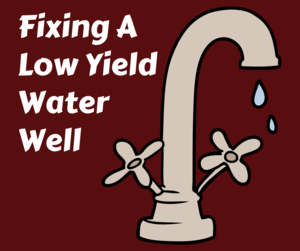CALL TODAY 1-800-441-6281
CALL TODAY 1-800-441-6281

Solving Residential Low Water Pressure Problems
- Tags:
- residential wells
Understanding Water Pressure Problems
For most well systems, water pressure is provided and regulated by the well pump. Different pumps have different capacities and the overall rate of flow is directly related to the pump capacity. If your household has a 10-gallon per minute demand, you’ll find that water trickles from the faucet if the pump can only supply five gallons per minute. View our information on low water pressure.
DIFFERENT LOW WATER PRESSURE SOLUTIONS
Adding pressure tank capacity can help a home meet high demand that exceeds of the pump’s capacity. Consult a professional to find out if an additional tank will work within your system. Remember, this will boost water pressure somewhat, but will not permanently solve the problem of the shower, dishwasher, washing machine, and other heavy appliances all running at the same time.
Homeowners can also replace their well pump with a variable speed pump. The speed of it is regulated by the demand for water and the motors can run up to two times faster than those with constant speeds.
A CONSTANT PRESSURE SYSTEM FILLS THE GAP
Private well systems are set up to run at a certain pressure measured in pounds per square inch (psi). A typical residential pump will be set at 40 to 60 psi. When the pressure in your tank drops below 40 psi, the pump starts and runs until the pressure reaches 60 psi and shuts off. When you use multiple water sources at once, like the shower and washing machine, water pressure drops quickly, and the well pump may not be able to keep up, leaving the shower sputtering.
When water demand inside the home goes up, a constant pressure system will maintain a constant pressure by changing the speed of the pump to meet the demand for water. Some systems use a sensor to detect water pressure and then send a signal to the controller to regulate the speed of the pump. When water demand increases, pump speed increases and when water demand decreases, the pump speed will decrease. Constant pressure systems do not require large tanks for storage. These systems are popular because they are compact and energy efficient solution.
BEFORE BUYING A CONSTANT PRESSURE SYSTEM
Not all low-pressure problems are caused by low pressure in the pressure tank. Low water pressure can also be caused by hard water. Minerals can build up in the pipes and diminish water pressure. While this is not a health concern, letting hard water go unaddressed will eventually damage water-using appliances and the home plumbing system.
Low pressure could mean that your well’s flow rate is below the needs of your family, and it is simply not getting enough water to your home. It could also be that your well pump is not sized properly. In some cases, the pump may be too small for the size of the home, or for the distance from the home.
We recommend homeowners have their well water pump serviced every five years to keep it functioning properly and to identify potential problems. During this service, we replace the pressure switch, the relief valve and boiler drain to make sure the system continues to run well. We also check the air pressure in the storage tank, examine the well cap and check the performance of the well pump. If all is well, we can continue to look for the low-pressure cause.
If you have questions about your well water system, or what is causing low water pressure in your home, contact Skillings & Sons today. Our technicians can help advise you on a solution that will keep your water flowing, even when water in your home is in high demand.

